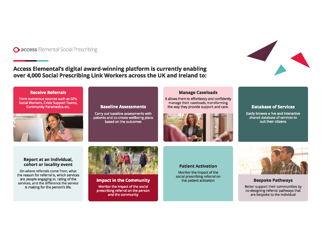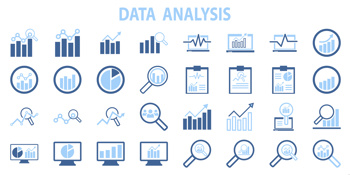The Best Methods to Measure the Impact of Social Prescribing
Social prescribing impacts can benefit people in many different ways, and if you are a social prescribing Link Worker you’ve probably been searching for the best methods to measure your impacts.
At Access Elemental Social Prescribing we want the clients to be the priority and not have their time limited due to unless admin that needs inputting.
Our social prescribing software help our clients with the difficulties in managing data by providing robust reporting methods to make tracking progress easier and reduce admin time.
Whether it’s using quantitative data, qualitative, or a mixture of the two, then this guide will provide all the information on the differences of each and how they have been used in practice to measure social prescribing impacts to identify which method is best for you.
You will also learn more about what is social prescribing so you can choose what works best for you.
Jump to section:
- Why is measuring social prescribing outcomes important?
- What are the pros and cons of using qualitative and quantitative data when measuring social prescribing impacts?
- The advantages and disadvantages of quantitative data in social prescribing:
- What outcome frameworks have influenced how to measure social prescribing impacts?
- How have frameworks which measure social prescribing impacts been developed?
- What are the examples of measuring social prescribing impacts?
- What are the main limitations in measuring social prescribing impacts?
- How can you overcome the limitations in measuring in social prescribing impacts?
- What is the best method in measuring social prescribing impacts?
Why is measuring social prescribing outcomes important?
Social prescribing services and projects all work towards the shared goal of helping to improve the health and well-being of individuals regardless of their age and background.
There is currently no standardised best practice for measuring the impacts of social prescribing. But, the evidence for social prescribing shows how there tends to be more positive impacts than negative ones.
Measuring the impacts of social prescribing outcomes is important because it allows social prescribers to see what works well and what doesn’t for each individual.
When measuring social prescribing outcomes it is important to understand the outcomes and the value of improving them. Using patient-reported outcomes is one efficient way to understand the impacts from the individuals’ perspective.

Measuring social prescribing impacts – What are the methods?
In the last decade both qualitative and quantitative data collection methods have been used to measure and assess the impacts and evidence for social prescribing.
What is quantitative data?
Quantitative data concentrates on gathering and assessing the numbers and statistics from the social prescribing schemes. Some examples include: GP and unscheduled care attendance rates, as well as the number of clinical prescriptions issued.
What is qualitative data?
Qualitative data concentrates on the user experience and the impacts their experiences have on their social prescribing journey. Examples include: surveys, questionnaires, and interviews.

What are the pros and cons of using qualitative and quantitative data when measuring social prescribing impacts?
When using qualitative and quantitative data to measure the impacts of social prescribing, both can provide advantages and disadvantages. One way to limit the amount of pitfalls and challenges when measuring social prescribing impacts and outcomes is to measure impacts with both qualitative and quantitative data.
The table below shows the advantages and disadvantages of using qualitative and quantitative data when measuring social prescribing impacts.
|
Advantages |
Disadvantages |
|
|
Quantitative Data |
|
|
|
Qualitative Data |
|
|

The advantages and disadvantages of quantitative data in social prescribing:
Advantages:
- More accurate conclusions on whether social prescribing is helping alleviate pressure for the NHS
- Less time-consuming meaning link workers can have more time with individuals
- Often more reliable and concrete conclusions can be made without having to take into consideration any ethical or personal external factors which could inhibit someone’s progress
Disadvantages:
- Only using quantitative data can result in a risk of missing the bigger picture in context when evaluating social prescribing impacts
- Data can be misleading e.g. an individual may have a reduced GP attendance but they might have mobility problems due to an injury making it harder to get to a surgery
- Quantitative data is not always effective as quantitative data does not record feelings
What outcome frameworks have influenced how to measure social prescribing impacts?
Patient reported outcome measures (PROMs)
Over the last 20 years the use of Patient Reported Outcome Measures (PROMs) has increased. PROMs are a type of questionnaire which patients complete by scoring the severity of each item independently and the results are used to analyse patient’s perspective to improve care delivery.
Patient reported experience measures (PREMs)
Patient report experience measures (PREMs) work in a similar way to PROMs but instead assess the process of care such as:
- The information they were provided with
- Level of trust in staff
- Waiting times
- Hospital hygiene
Mapping outcomes within tools:
The Social Prescribing Academy have released a list explaining how outcomes can be reported and set out in different categories:
- Increases in self-esteem and confidence, sense of control and empowerment
- Improvements in psychological or mental well-being and positive mood
- Reduction in symptoms of anxiety and/or depression and negative mood
- Improvements in physical health and a healthier lifestyle
- Increases in sociability, communication skills and making social connections
- Reduction in social isolation and loneliness
- Improvements in motivation providing hope and optimism about the future
- Acquisition of learning new interests and skills
Research conducted by the University of Westminster has also highlighted the benefits of splitting outcomes up into categories to easily monitor and track social prescribing impacts.
The research demonstrated how depending on the social prescribing service the way outcomes are categorised can differ. However, this process allows all outcomes to be reviewed in one place to easily see how a service is performing. Their suggested categories are:
- General e.g. quality of life and well-being
- Physical e.g. lifestyle factors such as: diet, drugs, alcohol
- Welfare e.g. level of education and qualifications, coping strategies
- Spiritual e.g. feeling a sense of purpose, relaxation, and motivation
- Psychological e.g. anxiety, self-esteem
- Social e.g. reduced loneliness, isolation
Breaking down the outcomes that you want to measure in categories in general and for each client makes reporting impacts more efficient and provides metrics to directly compare.
Learn more about how Access Elemental Social Prescribing software can support you.
How have frameworks which measure social prescribing impacts been developed?
In the process of developing frameworks to measure social prescribing impacts different adaptations of PROMs and PREMs have been used to apply the process in a non-clinical setting.
The addition of 2 national codes in the SNOMED codes has helped this process further, by incorporating and deploying 2 codes specifically related to social prescribing in all GP surgeries including: ‘social prescribing referral’ and ‘social prescribing declined’.
The NHS Social Prescribing and community-based support summary guide highlights when measuring social prescribing outcomes three areas must be covered:
- The individual
- The community group
- The healthcare system
For all three areas the NHS have published guidance to inform social prescribers what are the crucial things to remember.
The individual
Impacts will not be the same for everyone and it depends on the needs of the person but in general there are some key areas that need to be assessed:
- Do they feel more confident and can they manage their mental health better?
- Are they physically more active?
- Can they manage practical issues better?
- Are they better connected with others? E.g. reduced loneliness
The community group
The NHS recommend that co-produced and short ‘confidence surveys’ are used to assess local community groups and the VCSE sector’s confidence and resilience in managing the impact of referrals. Questions and ideas that should be addressed include:
- What is the staff/volunteer turnover?
- What is the capacity of the voluntary sector to manage referrals?
- What support do they need to sustain the service?
The healthcare system
The NHS recommend that all social prescribing services form a local partnership with robust sharing agreements to be able to access a variety of data and share mixed surveys to analyse the impact of social prescribing including:
- How social prescribing has affected GP attendance?
- How social prescribing has affected A and E attendance?
- How hospital bed numbers have changed because of social prescribing?
- How clinical prescriptions have changed because of social prescribing?
What are the examples of measuring social prescribing impacts?
Assessment and Questionnaire tools:
ONS Wellbeing Scale
The ONS Wellbeing scale is a survey of 4 questions used to measure personal wellbeing. Individuals are asked to respond to the questions on a scale from 0-10, with 0 meaning not at all and 10 completely. It asks questions on these 4 categories:
- Life satisfaction
- Worthwhile
- Happiness
- Anxiety
The ONS Wellbeing scale can be used when measuring social prescribing impacts to look at individuals scores from pre and post using social prescribing services to help track individual health journeys.
Self- developed social prescribing assessment and questionnaire tools:
A development many social prescribing services have made is to create their own self-developed assessment or questionnaire tool.
Short-Warwick-Edinburgh Mental Wellbeing Scale (SWEMWBS)
Short-Warwick-Edinburgh Mental Wellbeing Scale (SWEMWBS) is a tool that uses a list of 7 statements which clients have to rate on how far they agree with each statement. Each ranking would be linked with a score to identify the overall mental wellbeing score for the client. Clients are asked to fill out the survey 4 times across the year to allow data to be analysed and monitor progression.
In general SWEMWBS helps compare outcomes of different social prescribing schemes but it does not highlight the specific areas of mental wellbeing clients need support in. Nor does it help support Link Workers with action plans post assessments, so any adjustments in a client’s journey is dependent on own knowledge. It most cases this is not too challenging, however for a newly trained link worker this can be a struggle.
MYCaW
MYCaW is an individualised questionnaire which can be filled out both on paper and digitally. Initially developed in the holistic cancer settings, it has also been used in social prescribing schemes to measure how well their service meets the needs of an individual.
MYCaw works by embedding questionnaires into consultations to understand and prioritise what an individual needs support with:
- The 1st form the individual’s main concern is written down and rated for its severity using a numerical likert scale and their personal wellbeing is recorded in the same way.
- At the follow-up two additional questions are asked: is anything else important happening in your life and what is the most important thing about our service to you?
The questionnaire is validated against FACIT-SPEx to be responsive to change and detect both deterioration and improvements. Some social prescribers say it identifies the unmet needs of service users better than standard PROMs due to its sensitivity to change.
Scores are then analysed to identify if any changes in data are statistically significant and if any individuals’ needs have not been met. The combination of both quantitative and qualitative data establishes a benchmark for auditing purposes when expanding to new places, whilst informing future pathways of social prescribing.
Patient Activation Model
Patient Activation Model (PAM) uses a questionnaire of 13 statements on a 5-point scale and 4 activation levels along a 100 point scale.
Some Link Workers find PAM useful but they have to adapt their questions for clients on a case-by-case basis. It is not possible to access the calculation which PAM uses to turn a client’s response into a score as developers are reluctant to release it. For this reason results are not always valid so if this method is used it is important to be aware of these barriers and whether this is the best method for you.

What are the main limitations in measuring social prescribing impacts?
Due to a variety of tools being readily available there are sometimes limitations for more specific tools. Some tools reporting on wellbeing don’t always acknowledge the specific outcome a client is trying to improve, so tracking their individual progress isn’t as person-centred as it could be. Other tools that concentrate more on individual and local impacts miss analysing how social prescribing impacts us on a national level.
More generally for most social prescribers there are 7 limitations to be aware of:
- Not all tools integrate well with other clinical systems such as: EMIS Web and Systm 1
- Having no standardized approach can cause inconsistencies in how both quantitative and qualitative data is used
- Data can be difficult to collect sometimes taking up time and resources
- Identifying and defining categories to measure impacts and separating them can be difficult e.g. defining moods and anxiety
- There is limited reporting and measuring on how social prescribing impacts wider social determinants of health e.g. crime and welfare
- Subjective – many social prescribing services can be specific for a certain location so measuring impacts to then compare on a national level can be challenging
- Client participation can be limited – not all clients may consent to answering surveys and questionnaires making gathering a wide variety of data challenging

How can you overcome the limitations in measuring in social prescribing impacts?
To overcome limitations in measuring social prescribing impacts the biggest barrier that needs to be tackled is establishing a standardised approach for social prescribers to follow. Luckily, the NHS are now providing us more guidance with a Common Outcomes Framework.
In general however, there are some steps social prescribers can take into consideration when selecting the best method to measure social prescribing impacts:
- Ensure there is a broader range of outcomes including those related to the social determinants of health e.g. crime, legal, and housing
- Review NHS Common Outcomes Framework against your selected outcomes to ensure more impacts measuring social prescribing are captured
- Look into interoperability software within measurement tools so both quantitative and qualitative data can be easily integrated across different systems
- When reviewing impacts always considered them in three areas: the client, community and the nation as a whole
- Encourage client involvement from the start of their journey. Make them feel motivated to encourage more client participation when you are wanting surveys to be completed

What is the best method in measuring social prescribing impacts?
One method that will benefit most social prescribers is incorporating both quantitative and qualitative data. Forming local partnerships is one of the best ways to do this as it will provide you access with robust reporting systems to get all the required data you need from clinical systems.
When looking at how to measure well-being there are many tools available, however some may not benefit different social prescribing services as much as others. Patient Activation Models can work well for some social prescribers but for more larger services other tools may be more appropriate.
Its process and limited control in analysing scores can be very time consuming and sometimes generates results which are not always valid. Larger social prescribing projects may benefit from producing their own assessment tool if your funding allows you to do so to help your service specifically target the support your clients need.
It is important when selecting measurement well-being tools that they are simplistic and easy to use for both Link Workers and client’s themselves, to help encourage client participation. When selecting outcomes to measure it is important to consider how to categorise them and how information can integrate with other systems so all data can be found in one place.
Here we have evaluated the pros and cons of quantitative and qualitative data and how they have been used in practice to measure social prescribing impacts. With that considered if you are interested, Access Elemental Social Prescribing offer a variety of modules which could provide the best method for you.
Discover the benefits our some of our customers have experienced since working with us by reading our social prescribing case studies today.
Whether you are a small or large social prescribing service, discover our social prescribing software to see how our analytic and integration software can link your datasets across different systems all in one place, and help you manage your impacts to allow client’s to get the most out of their social prescribing journey.


 AU & NZ
AU & NZ
 SG
SG
 MY
MY
 US
US
 IE
IE





